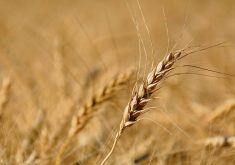Although there are always exceptions, precipitation across Saskatchewan seems to be back to normal after several years of drought and otherwise dry conditions.
But that also means disease of all kinds — including cereal leaf diseases — are coming out to play. And now is the time to get them, said a plant pathologist.
“For disease this is our peak season. That’s when fungicide decisions are made,” said Randy Kutcher with the University of Saskatchewan. The big cereal leaf diseases in the province tend to be tan spot in wheat and durum and net blotch in barley, he said. Durum has also attracted some septoria in the past as well as bacterial leaf streak, particularly among seed growers under irrigation. Cereal crops are usually sprayed for leaf diseases at the fully-unfurled flag leaf stage. However, most crops in Saskatchewan have already passed that benchmark, said Kutcher.
Read Also

Brazil to reap record soy crop in 2025/2026, increase exports
Brazil’s Conab said the country will reap a record soybean crop of 177.6 million tons in the 2025/2026 harvest year, according to data released on Thursday.
The good news is that many (if not most) cereal producers today use one fungicide pass to take out fusarium head blight (FHB) at flowering and hope that it will also have some impact on leaf diseases. Kutcher recommended that practice.
“I see there’s lots of spray tracks in some of the fields,” he said. “I would think a lot of that is for fusarium head blight, but that application of fungicide will also help to mitigate the leaf diseases to some effect. Generally we like to hit the leaf diseases a little earlier.”
When that flowering takes place, of course, depends on when growers seeded. Due to the cool, wet spring interfering with seeding in some cases, that timing may vary, said Kutcher. Regardless, it’s just nice to have moisture, he said. “We’ve had quite a number of dry years. so I think everybody’s pretty happy. We’ve had a bit of replenishment of moisture in the soil and pretty good growing conditions.”
Watch this space for more coverage of cereal leaf diseases on the Prairies.















